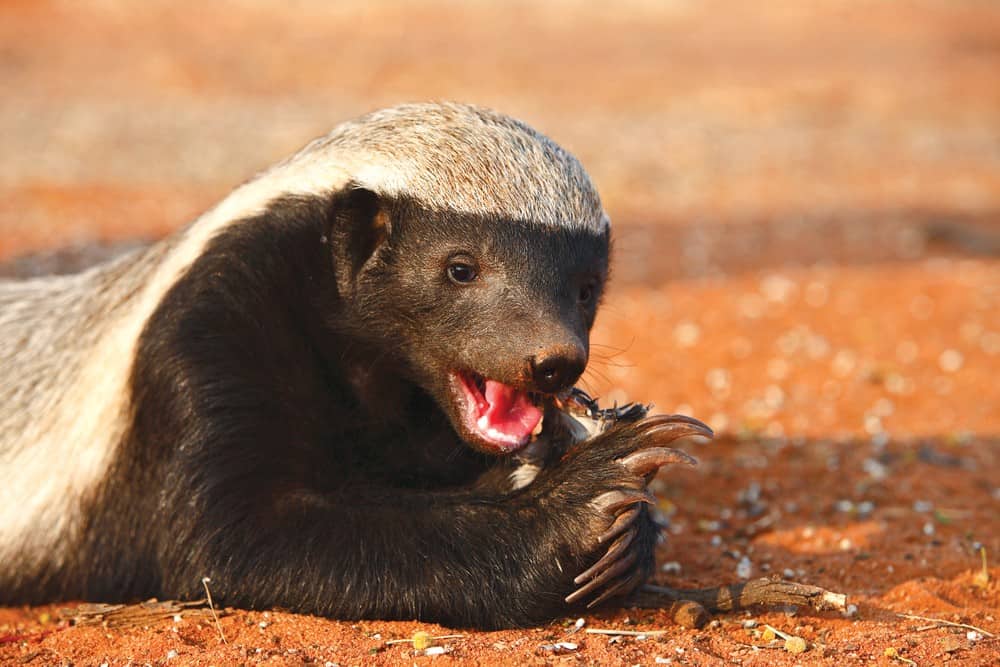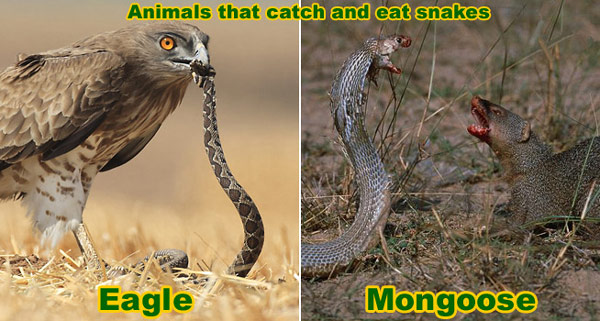What Eats Snakes: Predators in the Wild Revealed

Honey badgers, mongooses, secretary birds, harpy eagles, hawks, owls, wolverines, and bobcats are all animals that eat snakes. Raptors such as eagles and hawks, cranes, and secretary birds can occasionally eat snakes using their long legs and beaks.
Honey badgers and mongooses are known to be immune to certain types of snake venom and can easily take down venomous snakes. Wolverines and bobcats are also known to prey on snakes. However, the king cobra, which is one of the most venomous snakes in the world, has no natural predators.
Snakes are one of the most feared creatures on the planet due to their venomous nature, and they are often hunted by predators. We will explore the animals that eat snakes, including birds of prey, carnivorous mammals, and reptiles. We will also discuss the snake’s greatest enemy and the animals that snakes fear. Furthermore, we will look at the methods used to kill snakes around the house.
The Circle Of Life: Predatory Dynamics
When it comes to the natural world, the predator-prey relationship is a fundamental aspect of the ecosystem. This dynamic interaction between species is crucial for maintaining nature’s balance.
Nature’s Balance
In the intricate web of life, every creature plays a role in maintaining the delicate balance of the ecosystem. Predators help control prey populations, ensuring the health of the environment.
Predator And Prey Interactions
From birds of prey like eagles and hawks to agile mongooses and powerful secretary birds, there are various predators that keep snake populations in check. These animals have evolved unique hunting strategies to effectively capture and consume snakes.
- Eagles, Falcons, and Hawks: These raptors use their sharp talons and keen eyesight to hunt down snakes from the skies.
- Cranes: With their long legs and beaks, cranes can skillfully catch and consume snakes.
- Secretary Birds: These striking birds have a stomping technique that incapacitates snakes before they become a meal.
Snakes, in turn, have developed various defense mechanisms to evade their predators, such as venomous bites, camouflage, and swift movements. This ongoing evolutionary arms race ensures the survival of both predators and prey.
Birds Of Prey: Sky Hunters
Birds of prey, also known as raptors, are formidable hunters that dominate the skies with their keen eyesight, powerful talons, and remarkable agility. These aerial predators play a crucial role in controlling snake populations, making them a natural nemesis for these slithering reptiles.
Eagles And Hawks
Eagles and hawks are renowned for their predatory prowess, and they are not one to shy away from a juicy snake meal. With their sharp talons and exceptional vision, these avian hunters can swoop down on unsuspecting snakes with remarkable precision, making them a formidable threat to these reptiles.
Owls: Nocturnal Nemesis
Owls, the masters of the night sky, are another group of birds of prey that pose a significant threat to snakes. With their silent flight and acute hearing, owls are highly effective nocturnal hunters, making them a formidable nemesis for snakes that are active during the night.
Mammalian Adversaries
When it comes to the animal kingdom, snakes face formidable adversaries in the form of mammals. Let’s explore some of the mammalian predators that pose a threat to these slithering reptiles.
Mongoose: The Cobra’s Foe
The mongoose is renowned for its agility and quick reflexes, making it a formidable foe for cobras. With lightning-fast movements, the mongoose can swiftly dart in and deliver a fatal bite to the back of a cobra’s neck before the snake can mount a defense. This makes the mongoose one of the most renowned predators of snakes, particularly cobras.
Badgers And Wolverines
American badgers and wolverines are carnivorous mammals that are known to prey on snakes. American badgers, in particular, are considered prime predators of rattlesnakes. With their powerful digging abilities, badgers can unearth snakes from their hiding spots and swiftly dispatch them, making them a significant threat to snakes in their natural habitats.
Cats: Bobcats And Other Felines
Various feline predators, including bobcats, are known to hunt and consume snakes. These agile and stealthy hunters are capable of ambushing snakes, using their sharp claws and teeth to overpower and devour them. While not as specialized as mongooses or badgers, cats are still formidable predators of snakes in their respective environments.

Credit: www.ultimatekilimanjaro.com
Reptilian Rivalries
Reptiles have a long history of rivalry, particularly when it comes to survival. In the world of serpents, there are numerous species that pose a threat to one another. Let’s delve into the fascinating world of reptilian rivalries and explore the predators that pose a danger to snakes.
Kingsnakes: Cannibalistic Tendencies
Kingsnakes, known for their impressive constricting abilities, are not just a threat to other species of snakes, but also to their own kind. These cannibalistic tendencies make them formidable predators in the reptilian world.
Cobras: Snake-on-snake Predation
Cobras, with their venomous bites and swift strikes, are not only a threat to other animals but also engage in snake-on-snake predation. They are known to be a formidable adversary to their fellow serpents, making them a force to be reckoned with in the reptilian ecosystem.
Amphibious Assassins
When it comes to creatures that devour snakes, amphibians are often overlooked. However, some amphibious predators are adept at hunting and consuming these slithering reptiles. Let’s dive into the world of these Amphibious Assassins and explore their unique methods of preying on snakes.
Alligators And Crocodiles
Alligators and crocodiles are formidable predators known for their powerful jaws and stealthy hunting techniques. These reptiles lurk beneath the water’s surface, patiently waiting for unsuspecting snakes to venture near the shore. With lightning-fast movements, they ambush their prey, using their razor-sharp teeth to deliver a fatal bite. Once the snake is subdued, these amphibious assassins will consume their prey whole, demonstrating their dominance in the wetlands.
Amphibians With A Taste For Snakes
Amphibians such as bullfrogs and salamanders are not to be underestimated when it comes to their appetite for snakes. These agile hunters utilize their lightning-fast tongues to snatch unsuspecting snakes with remarkable precision. With a swift and calculated strike, they immobilize their prey before engulfing them in a single gulp. Their voracious appetite for snakes showcases the remarkable diversity of predators within the amphibian kingdom.
Insectivores And Rodents
When it comes to creatures that prey on snakes, insectivores and rodents play a significant role in maintaining the ecological balance. These small but mighty animals are adept at hunting and consuming snakes, playing a crucial part in controlling snake populations in various ecosystems.
Hedgehogs: Spiky Predators
Hedgehogs are opportunistic feeders, consuming a variety of insects, small mammals, and reptiles, including snakes. Their sharp spines act as a defense mechanism, enabling them to confront and overpower snakes with their quick movements.
Opossums: Opportunistic Eaters
Opossums are known for their diverse diet, which includes snakes. These adaptable creatures are opportunistic feeders, preying on small reptiles and rodents, making them a potential threat to snakes in their habitat.
Human Impact
Humans have had a significant impact on the natural predators of snakes through traditional hunting practices and modern encroachments.
Traditional Hunting Practices
In many cultures, snakes have been hunted for their skin, meat, and medicinal purposes. Indigenous communities have historically utilized traditional hunting methods to catch and kill snakes, disrupting the natural predator-prey balance.
Modern Encroachments
Urbanization and habitat destruction have encroached upon the natural habitats of snake predators, leading to a decline in their population. Deforestation and land development have reduced the availability of prey for snake predators, thereby impacting their ability to control snake populations.

Credit: www.wildlife-removal.com
Defensive Strategies Of Snakes
Snakes have evolved various defensive strategies to protect themselves from predators and threats in their environment. Let’s explore two key defensive mechanisms that snakes employ:
Camouflage And Escape
Camouflage: Snakes use their coloration and patterns to blend into their surroundings, making it challenging for predators to spot them. This natural camouflage allows snakes to hide in plain sight and avoid detection.
Escape: When faced with danger, snakes rely on their speed and agility to swiftly retreat to safety. Some snakes are exceptional climbers or burrowers, utilizing their environment to escape predators effectively.
Venom: A Double-edged Sword
Venom: Snakes possess venomous glands that produce toxins used for defense and hunting. While venom can be a potent weapon against threats, it also comes with risks. Snakes must carefully control the amount of venom they inject to avoid depleting their reserves.
Double-Edged Sword: The venom of snakes can be both a defensive mechanism and a means of subduing prey. However, the production and delivery of venom require precision to ensure the snake’s survival.
Conservation Efforts
Protecting snake habitats is crucial for maintaining a balanced ecosystem. By safeguarding their natural environments, we can ensure the survival of these essential creatures.
Protecting Snake Habitats
Preserving the habitats of snakes helps maintain biodiversity and supports the delicate balance of nature. Efforts such as creating protected areas and restoring degraded habitats play a vital role in ensuring the well-being of snake populations.
Promoting Biodiversity
Encouraging biodiversity not only benefits snakes but also contributes to the overall health of ecosystems. By protecting the diverse range of species that snakes interact with, we can help sustain their populations and the ecosystems they are a part of.
Cultural Perspectives
Various animals prey on snakes, including raptors like eagles, hawks, and owls, as well as cranes and secretary birds. Other predators include the honey badger, mongoose, wolverine, and bobcat. The snake’s biggest enemy is the mongoose, which is quick enough to bite the back of a cobra’s neck before it can defend itself.
Snakes In Mythology
Throughout history, snakes have played a significant role in various mythologies and folklore around the world. In many cultures, snakes are often associated with both positive and negative symbolism.
Contemporary Views On Snakes
In modern times, snakes continue to captivate the human imagination. While some view them as dangerous creatures to be feared and avoided, others appreciate their important role in maintaining ecological balance.

Credit: earthlife.net
Frequently Asked Questions
What Animal Eats Snakes?
Eagles, hawks, cranes, secretary birds and mongoose are some animals that eat snakes. Raptors like bald eagles and various hawks prey on snakes, while cranes and secretary birds can occasionally eat snakes using their long legs and beaks. The mongoose is also a predator that can kill snakes quickly by biting the back of the snake’s neck.
What Is The Snake’s Greatest Enemy?
The snake’s greatest enemy is the mongoose, known for its speed and ability to bite before the snake defends itself.
What Animals Are Snakes Afraid Of?
Birds of prey, like eagles and hawks, are natural predators that snakes fear due to their keen senses and hunting abilities.
What Kills Snakes Faster?
Snake traps are the fastest way to kill snakes. Lethal traps lure and snap snakes instantly, ensuring a quick and humane death.
Conclusion
Various animals like eagles, hawks, cranes, and secretary birds are natural predators of snakes. Additionally, snakes themselves, such as kingsnakes, can also eat other snakes. Understanding the predator-prey dynamics of snakes is crucial for their survival in the wild.



